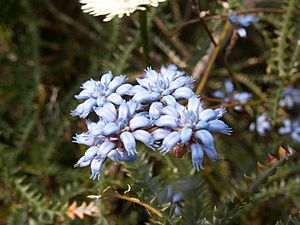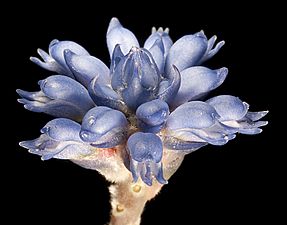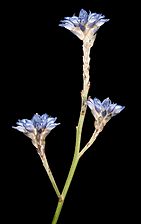Blue brother facts for kids
Quick facts for kids Blue brother |
|
|---|---|
 |
|
| Scientific classification | |
| Genus: |
Conospermum
|
| Species: |
caeruleum
|
| Synonyms | |
|
Connospermum coeruleum B.D.Jacks. orth. var. |
|
The Conospermum caeruleum, also known as blue brother, is a cool shrub found only in the southwest part of Western Australia. It belongs to the Proteaceae plant family. This plant usually grows low to the ground and has small, tight groups of blue flowers. Sometimes, you might even see pink ones! It likes to grow in heavy soils that can get flooded.
Contents
What the Blue Brother Looks Like
This plant is a low-growing or sprawling shrub. It usually reaches about 0.5–1.0 metre (2–3 ft) tall and can spread up to 2 metres (7 ft) wide. Its leaves grow in bunches near the bottom of the stem. Each leaf has a stalk that is 5–60 millimetres (0.2–2 in) long. The leaf itself can be thin and thread-like or shaped like an egg, measuring 14–148 millimetres (0.6–6 in). You can see clear lines (veins) on the leaves, and they end with a sharp point.
The flowers are blue and look like small tubes. They grow in tight groups, with up to 18 flowers in each cluster. Each flower is about 5–8 millimetres (0.2–0.3 in) long. You can usually see these flowers between July and October. After the flowers, small fruits called nuts appear. These nuts are about 2 millimetres (0.08 in) long and 2–2.5 millimetres (0.08–0.1 in) wide.
How This Plant Got Its Name
The Conospermum caeruleum was first officially described in 1810. A botanist named Robert Brown gave it its scientific name. He wrote about it in a publication called Transactions of the Linnean Society of London. He found a sample of the plant near King George's Sound in what was then called "New Holland" (which is now Australia).
The second part of its scientific name, caeruleum, is a Latin word. It means "sky-blue," which makes sense because of the plant's blue flowers!
There are six different types, or subspecies, of Conospermum caeruleum. They are:
- Conospermum caeruleum R.Br. subsp. caeruleum
- Conospermum caeruleum subsp. contortum E. M. Benn.
- Conospermum caeruleum subsp. debile Meisn. E.M. Benn.
- Conospermum caeruleum subsp. marginatum Meisn. E.M. Benn.
- Conospermum caeruleum subsp. oblanceolatum E. M. Benn.
- Conospermum caeruleum subsp. spathulatum Benth. E.M. Benn.
Where the Blue Brother Grows
The Conospermum caeruleum grows in many areas across Western Australia. You can find it from Busselton all the way to the east of Albany. It lives in different biogeographical regions like the Avon Wheatbelt, Esperance, Geraldton Sandplains, Jarrah Forest, Mallee, Swan Coastal Plain, and Warren.
This plant can grow in various types of soil, including sand, sandy peat, stony clay, laterite, or granite. It especially likes places that get wet during the winter months.
Is It Endangered?
Good news! The Government of Western Australia Department of Parks and Wildlife says that the Conospermum caeruleum is "not threatened." This means it's not currently in danger of disappearing.
Gallery



